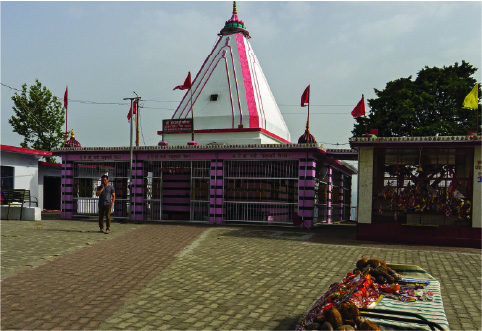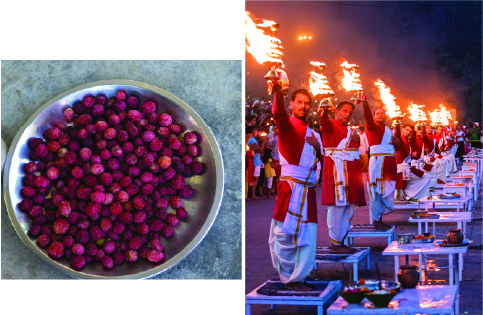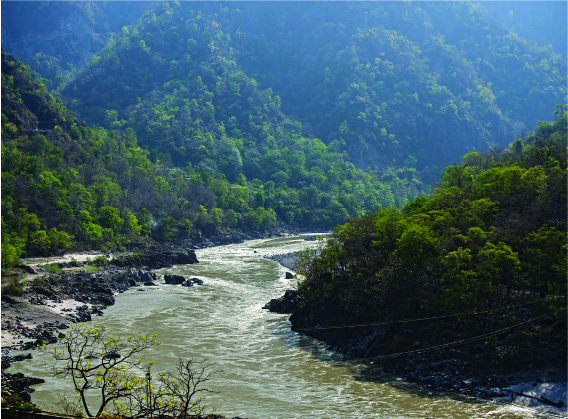Soul searching is a serious preoccupation in the pilgrim town of Rishikesh in Uttarakhand. And it has always been that way, with ancient rishis and yogis meditating by the banks of the holy Ganga which winds through the town on its way to the plains.
Dotted with ashrams where international and domestic seekers of nirvana proffer bruised souls for healing, this noisy town’s magical backdrop contributes greatly to its spiritual vibe. Called Dev Bhoomi or Abode of the Gods, Rishikesh is embraced by the Shivaliks, the foothills of the Himalayas, which are now a playground for trekkers in search of more temporal pursuits.
We were staying at the hilltop destination spa, Ananda in the Himalayas, which snuggles in the former residence of the Maharaja of Tehri Garhwal. We woke up early one morning to embark on a trek and gazed down at Rishikesh (located a 40-minute drive away), as it uncurled itself awake. The wind carried the toll of temple bells and chanting like a sweet song, an invocation to the mountain gods to heal and bless the world. We would have lingered but an invigorating trek beckoned.

We drove to Kashmouli village and began our trek during which we would ascend 5,000 ft. Green terraced fields of ginger unfurled around us, with an isolated home or two, balanced on the lip of a ridge. Soon, the early morning mist lifted like a bridal veil in flight to reveal minuscule dreamy villages standing in the midst of lush fields. Led by our guide, we huffed and puffed upward, and encountered a few locals heading to their fields and a group of school girls toting back packs as they trekked happily to school, 2 km away.
Along the way, we saw women shimmy up trees to collect the local sweet-sour berries called kafal. One of them sat on the balcony of her home and offered us a platter with a smile. She was a handsome woman of the hills, tall, strapping and light-eyed like a gazelle and as sure-footed. A young woman working in her fields of ginger stopped to wave at us. These were idyllic snapshots of life in the hills which seemed to un-spool in consonance with the seasons and with nature rather than in conflict with it.
On our trek we were accompanied by melodic bird calls of barbells, babblers, drongos, magpies, bulbuls and golden eagles that took flight at our approach, daubing the skies with their vibrant colours. Our guide identified them by their calls which merged into a beautiful tapestry of sound.

We reached our destination after a couple of hours – a flat plateau-like expanse where two lonely shrines to Bhairav and Durga stood as though to keep vigil on the world that flared below. A shed-like playschool for village children had just opened when we arrived, and a village belle entered with three kids in tow. We told her that she was one of the most beautiful women we had ever seen and she accepted our compliment with philosophical grace. “What is the point of being beautiful? I work in the fields and soon I will look as old as the hills around me!”
On our downward descent, our guide identified plants with healing properties – plants that control diabetes, cure jaundice and heal cuts and bruises. He regaled us with stories of the people’s love for the Maharaja of Tehri Garhwal, one of three districts that surrounds the holy town. Once when the Maharaja was driving past in his car, he saw a half-blind local sitting on his haunches by the wayside. He asked the old man what he was doing. The old man responded: “I have heard that the Maharaja is going to pass by this way on his way to holy Uttar Kashi. If I get a glimpse of him, it will be as good as having gone to Uttar Kashi myself. “The Maharaja revealed his identity and the man was delighted and was soon on his way home, content in the knowledge that he had not only met his king and protector but also completed his pilgrim’s trail.
The trek from Rishikesh to Kunjapuri temple was on our agenda two days later, and it was a more challenging one. It would take four hours to climb uphill and cover a distance of 11 km. We did a part of the journey by car, and rest of the time, walked along a chortling stream, had breakfast by a waterfall, swung past villages that snoozed under the sun, even as Rishikesh and the broad swathe of the Ganga spread out below us like a relief map.

Towards the end of the trek, we climbed steep steps up to the temple, dedicated to Goddess Sati, pursued by glaring monkeys that resented our intrusion in their tranquil terrain. Kunjapuri temple, enfolded in the serenity of the mountains was deserted barring a priest who was praying quietly in its confines.
Soon we were trekking downhill. Deer watched us from behind a thicket and a peacock danced and flaunted its magnificent plumage in an effort to attract a disinterested mate. We again revelled in nature’s largesse the following day when we trekked to Ranichouri for a view of the snow-smothered Himalayas, inhaling the fugitive scent of pine and cedar and the sight of mimosa and jacaranda trees. Enroute we passed Sabli village, a typical Garhwali hamlet, where life tiptoes along as it has for centuries. We picnicked in a grove of pines before hoofing up to a lookout for a sweeping view of jagged mountains.
On our last evening, we attended the evening aarti held on the banks of the Ganga in Rishikesh and watched as flames of devotion lit by devotees leapt and crackled toward the velvety dark. Boundless joy suffused us with warmth on that chilly evening. Was it in search of this evanescent joy that lost souls converge on this holy town? In the mountains and in Rishikesh, we had briefly tuned into the beating heartbeat of human kind itself.
Fact File
Rishikesh is well connected by air, rail and road with the rest of the country. The temple town has a number of hotels (including ashrams). Ananda in the Himalayas, the award-winning destination spa, is located a 40-minute drive away.
Rishikesh today is at the heart of the adventure tourism industry thanks to opportunities to trek in the Shivaliks and white water rafting on the Ganga.
For more information visit https://uttarakhandtourism.gov.in/destination/rishikesh


 [/column]
[/column]